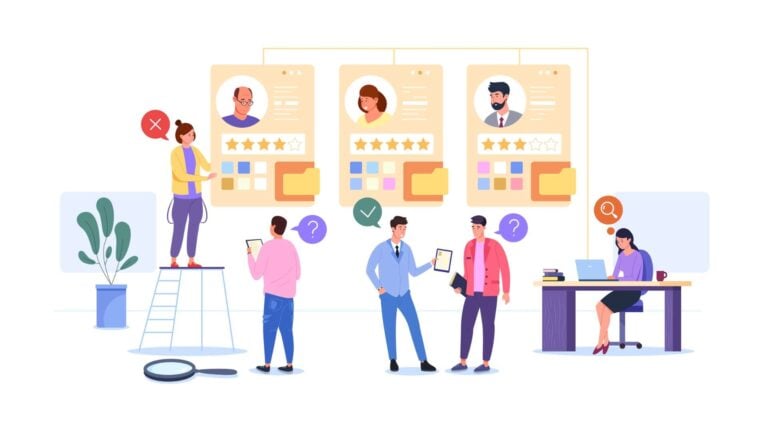Employee profiles are documents that summarize key information about each of your workers, such as their skills, experience, goals, and interests. In this guide, we discuss the benefits of employee profiles and show you how to use them properly.
Employee profiles provide detailed snapshots of your workers—highlighting their skills, experience, career aspirations, and more.
They’re essential for maintaining a clear understanding of all your team members and helping your workforce collaborate and communicate effectively.
They also help you make better decisions about promotions and professional development opportunities and simplify human resource (HR) management tasks.
Plus, employee profiles boost employee engagement and give them a sense of ownership over their growth at your company.
All this said, it can be tricky to know what to include in employee profiles and how to get the most value out of them.
We’re here to help!
Our guide below explains everything you need to know about employee profiles—including their benefits, steps to create them, and more.
Key Takeaways
- Employee profiles provide a detailed overview of each employee’s skills, experience, career aspirations, and even personal interests.
- Most profiles include the employee’s contact information, professional history, education and certifications, skills and competencies, achievements and recognition, career goals, and hobbies and interests.
- There’s no universal format for an employee profile, but it’s a good idea to create a custom template that works for your business.
- Employee profiles help improve communication, collaboration, efficiency, and engagement. They also simplify HR management and make it easier for you to identify potential leaders at your company.
- To create effective employee profiles, you need a well-organized template, good employee participation, and a secure place to store them.
What Is an Employee Profile?
An employee profile is a document that summarizes key information about an employee. This includes their name, contact details, job title, education, work experience, skills, achievements, hobbies, and preferences.
Think of it as a mini resume, or a professional social media profile page, that gives you an idea of who the employee is and what they bring to the table.
The employer and the employee work together to create the employee profile. Managers, HR departments, and other employees can then use them to understand a team member’s role, responsibilities, and potential career path within the organization.
Importantly, employee profiles aren’t static records. They’re “living” documents that change and develop as each employee grows. Whether it’s an updated certification, a newly acquired skill, or a change in job role, all new information goes into an employee profile.
Alternative terms for “employee profile”
Employee profiles can go by different names depending on the context, industry, or specific usage within a company.
You might hear them referred to as:
- Employee records
- Personnel files
- Employee files
- Staff profiles
- Employee dossiers
- Workforce profiles
- Team member profiles
Employee profiles vs. employee directories
While employee directories and employee profiles both contain information about workers, they serve different purposes.
An employee directory is typically a simple list or database of employees, often designed for quick reference. It usually includes basic contact information such as names, job titles, departments, phone numbers, and email addresses.
An employee profile is a more comprehensive set of data about an individual employee. While it includes basic contact information, it also includes detailed information such as an employee’s professional skills, experience, educational background, accomplishments, job responsibilities, career aspirations, and even personal interests in some cases.
Benefits of Employee Profiles
Creating and maintaining employee profiles can have many benefits for both you, as an employer, and your employees. We break them down below.
Benefits for employers
- More efficient HR. Employee profiles centralize essential information about each worker. This makes it easy for your HR staff to manage personnel data, track employee performance, monitor compliance, and more.
- Time savings. Having quick and easy access to employee information also eliminates the need to spend time searching for data.
- Informed decision-making. With a clear overview of each employee’s skills and experiences, you and other managers at your company can make more informed decisions about promotions, project allocations, and professional development opportunities.
- Easier succession planning. Similarly, detailed employee profiles offer insight into the employees who could become leaders within your organization. This enables better talent management and smoother succession planning.
- Improved communication. Employee profiles can help improve communication between you and your team members. They offer a comprehensive overview of each worker’s roles, responsibilities, contact details, and interests, facilitating smooth interactions.
- Enhanced collaboration. These profiles also help promote collaboration across your team. They offer a central repository of information about each employee’s skills and expertise, making it easier for coworkers to coordinate and work together efficiently.
Benefits for employees
- Career development. Employees can use their profiles to track their own progress, identify areas for improvement, and chart a course for career development.
- Greater visibility. A well-maintained profile helps an employee’s achievements, skills, and qualifications be more visible to decision-makers. It’s a great way to build their personal brand and reputation within the organization. This can be especially true for remote employees or entire teams working remotely who don’t often interact with another in person.
- Increased engagement. Creating and updating their profiles allows employees to feel more engaged with their roles, their career path, and the organization as a whole.
- Work-life balance. Employees can specify preferred communication methods and timings in their profiles, ensuring colleagues respect their personal boundaries, reducing out-of-hours disturbances and providing them with a right to disconnect.
- Self-management. By actively updating their profiles with new skills or certificates, employees take the reins of their growth in the company, giving them a satisfying sense of ownership.
What to Include in an Employee Profile
The information that’s important to include in an employee profile will vary between companies, and there’s no universal format for creating one.
However, there are some common sections typically included in employee profiles. These include:
Basic information
This includes the employee’s full name, job title, department, and contact information. This section aims to offer a quick overview of the employee’s role and how to reach them.
Professional history
This section provides a comprehensive picture of the employee experience and career path—both within your organization and at previous workplaces. It includes start and end dates, roles held, key responsibilities, and significant accomplishments.
Education and certifications
The educational background section should detail the degrees an employee has earned, the institutions they attended, and their fields of study.
In addition, it should include any relevant professional certifications or licenses, such as construction certifications, to highlight the employee’s specific qualifications.
Skills and competencies
This portion outlines the employee’s hard and soft skills. Hard skills might include proficiency in certain software programs, fluency in foreign languages, or technical capabilities. Soft skills could encompass leadership, communication, problem-solving, or adaptability.
Achievements and recognition

Dedicated to awards and accolades, this section can help an employee stand out. This might include employee-of-the-month awards, completed projects, exceeded targets, or other forms of recognition received during their time at your company or in previous roles.
Did You Know?
Connecteam can help you develop a rewards and recognition program at your company.You can show appreciation through personalized recognition badges, private thank-you messages, public shoutouts, and digital tokens workers can exchange for gift cards.
Get started with Connecteam for free today!
Career goals
Having a section for employees’ career ambitions helps you see where they want to go professionally. This can help you and other managers connect individual worker goals with your company’s bigger plans.
Hobbies and interests
This final section adds a personal touch to your employees’ profiles and helps enhance interpersonal relationships within your workplace. Information about workers’ hobbies, interests, passions, and fun facts can give colleagues common ground and foster a sense of community across your company.
Employee Profile Example
Below is an example of a good employee profile for an HR Generalist.
Name: Jane Doe
Job Title: HR Generalist
Department: Human Resources
Employment Date: June 1, 2019
Email: [email protected]
Contact: 123-456-7890
Location: Office 205, Main Building, New York
Skills: Employee Relations, Onboarding, HR Policies, Talent Acquisition, Payroll
Education:
B.A. Human Resources Management, XYZ University
Certified Professional in Human Resources (PHR)
Professional Experience:
HR Assistant at ABC Company (2016-2019)
HR Generalist at Current Company (2019-Present)
Achievements:
Implemented a new onboarding process, reducing new hire churn by 20%.
Led the initiative to introduce flexible working hours.
Career Goals: Aspires to move into an HR Manager role within the next 2 years.
Hobbies and Interests: Enjoys hiking, crocheting, and reading non-fiction books.
Personal Quote: “People are the heartbeat of every organization, and I’m passionate about creating the best work environment for them.”
How to Get Started With Employee Profiles
Set your objectives
Before you dive into creating employee profiles, clearly outline why you’re undertaking this initiative and what you hope to achieve. Are you aiming to enhance internal communication, facilitate team building, or support career development?
By defining your purpose and objectives upfront, you can ensure you gather the right information from your workers. Doing so also helps your employees understand the purpose and importance of completing their profiles.
Create an employee profile template
While there are no one-size-fits-all employee profile templates, crafting a unique one for your business helps ensure consistency and clarity across the board.
You can use word processing tools like Microsoft Word or Google Docs to create your template. Then, you can share the template digitally or print it out and share physical copies with employees. We recommend going all digital and implementing employee profile software like Connecteam to save time, money, and effort.
Your template should outline all the information employees must include in their profiles. It should also:
- Be easy to follow. A well-structured template ensures team members can quickly locate and read all information in a profile. Use a consistent font type, font size, and heading styles. Also, consider using icons for sections like contact details or skills to make them stand out.
- Include clear instructions. Provide an example for each section to give employees an idea of expected information—e.g., “Career Goals: Aims to become a shift coordinator within the next year.” Also, clearly mark which sections are mandatory to fill out and which are optional. These instructions will help prevent inconsistencies and ensure every profile is completed correctly.
- Have flexibility. While consistency is key, your template should be adaptable enough to cater to employees from diverse roles and backgrounds. Some sections might be relevant for one employee but not for another. It’s a good practice to allow employees to leave certain sections blank based on relevance. For instance, you can mark “Location” as an optional section for workers who aren’t based in an office.
Get people on board
The success of these profiles depends largely on employee participation. A great way to encourage this is to ensure your team members see the value of employee profiles—both for them as individuals and the company as a whole.
Hold a meeting or send out an all-team email covering the benefits of employee profiles. Also, encourage your team members to ask questions or raise concerns they may have about the profiles. This can help reduce employees’ potential hesitation in completing them.
Pro Tip
Boost participation even further by letting your team members know you and other managers at the company will fill out employee profiles. This sets a good example and helps encourage others to follow suit.
Collect the information
Next, it’s time to ask employees to fill out their profiles. You can do so by sending an email, scheduling an in-person meeting, or using your internal communication platform to share an update.
Along with the template, you can provide a guide detailing the steps to fill out and submit the profile. This can be in the form of a PDF, a video tutorial, or an online walkthrough. In addition, be sure to allow employees to give feedback or ask questions regarding the profile process.
Pro Tip
For new and future employees, make writing the profile a standard part of the hiring process. Include it as a step during onboarding so you have the information as early as possible.
Once employees have filled out their profiles, you should send them regular reminders encouraging them to update their profiles to reflect any changes or achievements.
Store them in a centralized system
Next, store completed employee profiles in a central location that’s easy to access and navigate. You can do this by using software like Connecteam. Our platform offers a document management tool and a secure knowledge base to store and manage all important company information.
With all profiles in one place, your managers, HR staff, and employees can quickly find the information they need without any delays and discrepancies. This can help streamline collaboration and communication and make it easier for new employees to get familiar with their colleagues.
Ensure privacy and security
Some workers might resist writing an employee profile because they’re concerned about privacy. In fact, a Forrester survey found that more than 50% of workers worldwide wish they had more data privacy at work, and about 50% actively limit how much personal information they share with employers.
To help put employees at ease, ensure you store profiles securely and have strong access permissions in place. The best option is to use a digital platform like Connecteam, which backs all data up to a secure private cloud and lets you set custom permissions for each user. It also encrypts data end-to-end.
These features ensure sensitive information is available only to those who need it—and that no unauthorized users can view employees’ personal data. This can help workers feel more comfortable completing their profiles.
Use them wisely
Filling out employee profiles isn’t just a one-and-done exercise. They can be a powerful resource in succession planning, HR management, training and development opportunities, and more. So ensure you treat them as a tool rather than documentation that collects dust.
For instance, when new projects emerge, you can delve into profiles to find the perfect employees for them rather than relying solely on memory or immediate team visibility. You can also turn to profiles when deciding who to give promotions to or when filling open roles at your organization.
Likewise, your HR staff can use employee profiles to identify knowledge and skills gaps in your company. Then, they can design personalized training and development programs to fill these gaps. This could be either on an individual, team, or company-wide basis.

Did You Know?
You can use Connecteam to create customized training courses and materials and deliver them straight to your workers’ mobile devices.
Get started with Connecteam for free today!
Finally, encourage your employees to look at their colleagues’ profiles. Employees can easily review their coworkers’ job titles, contact details, professional backgrounds, unique skills, and more.
This will improve communication and collaboration, especially across teams and departments, and therefore boost productivity at your company. It also contributes to a company culture of openness and transparency.
Conclusion
Whether you’re a budding startup, a mid-sized company, or a large enterprise, creating employee profiles is crucial to clearly understand who your team members are, what they can do, and where they can excel.
When used properly, these profiles can help create a more engaged workforce, improve collaboration and communication, streamline HR tasks, simplify succession planning, and more.
However, employee profiles’ success depends on accurate information, regular updates, and effective usage. You can simplify managing and accessing these profiles by using software like Connecteam. Our platform lets you securely store, organize, and update all your employee profiles (and other important company documents).
FAQs
What is employee profile management?
Employee profile management involves creating, updating, and maintaining profiles within an organization. These profiles facilitate strong decision-making, improve communication, and boost employee engagement.
Why are employee profiles important?
Employee profiles are important for several reasons. They provide details about workers’ contact information, professional backgrounds, skills, interests, and more that are easy to access and read. This information can help you make more informed decisions, communicate with your employees more effectively, and tailor your training and development efforts to individual worker needs.
Plus, employee profiles make it easier for you to spot potential leaders on your team, help keep employees engaged with their professional growth, and foster a sense of togetherness at your organization.




